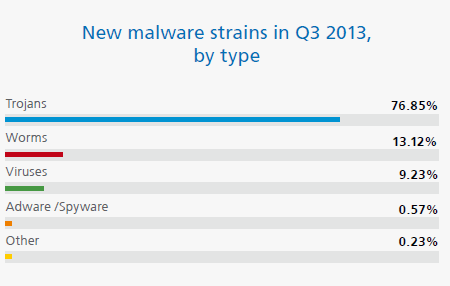The Panda Security published a report for the third quarter of 2013. The study focuses on malware, attacks with DNS poisoning, malicious software for mobile and spyware actions by the NSA.
With regard to malware, data show that nearly 10 million new malware has been detected so far 2013. A number much larger than the number of malware detected last year.
Nearly 77% of all new malware samples detected in the last quarter were Trojans, 13% were worms and the 9% were viruses. Trojans can be blamed for most infections. CryptoLocker is one of the most notable threats we saw in the third quarter of 2013.
Experts found that Latin America is the region most affected by malware. In China, nearly 60% of computers were found to be infected with one malware.
The lowest infection rates were recorded in European countries countries such as the Netherlands, the United Kingdom and Germany.
As far as mobiles are concerned, the platform Google's Android is still the most targeted. However, experts note that some of the high-profile attacks also target Apple's iOS.
The report also reports that hackers are increasingly using techniques DNS cache poisoning targeting large companies such as Google, Microsoft and various security companies.
The espionage of the NSA takes a large part in her recent report Panda Labs.
"Everything seems to indicate that there will be more revelations about more NSA surveillance programs indiscriminately spying on users, businesses and governments around the world," said Luis Corrons, PandaLabs's Technical Director.
For more details, see full Panda report for the 3 quarter of 2013. (PDF)







